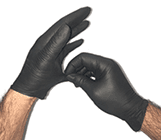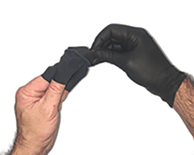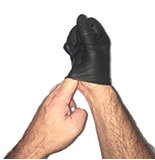
Online CPR/AED/First-Aid Class
Taking Universal Precautions
Once you know that the scene is safe, there are universal safety precautions you should take. Since you won’t know for sure, you should act with the assumption that all blood and bodily fluids contain disease-causing germs
Personal Protective Equipment (PPE)
Your first aid kit should include personal protective equipment (PPE) such as disposable gloves and goggles. These help to keep you safe from blood, saliva, and urine.
Some people have allergic reactions to latex, so non-latex gloves should be used if possible.
Actions for Universal Precautions
Wear personal protective equipment whenever necessary. Protective gloves are to be used whenever you give first aid. Eye protection should be worn if the ill or injured person is bleeding.
Place any disposable equipment that has touched blood or bodily fluids in a biohazard waste bag. Dispose of the bag according to company policy
After removing your gloves, wash your hands thoroughly with soap and water for at least 20 seconds.

Actions for Exposure to Blood
You should wear PPE whenever you can. In the event that the person’s blood makes contact with your skin, or splashes in your mouth or eyes, follow these steps.
- ● Remove your gloves
- ● Immediately and thoroughly wash your hands, for 20 seconds
- ● Rinse your eyes, nose, or mouth with water if blood has made contact with any of these areas
- ● Contact a healthcare provider as soon as possible
Properly Removing Protective Gloves
In addition to wearing protective gloves, you will also need to know how to remove them, in order to protect yourself and others from potential infection. Disposing of protective gloves properly is an important step.
To properly remove protective gloves:
- ● Grip one glove on the outside near the cuff, and peel it down until it comes off inside out.
- ● Cup it with your other gloved hand.
- ● Place 2 fingers of your bare hand inside the cuff of the glove that is still on your other hand.
- ● Peel that glove off so that it comes off inside out with the first glove inside it.
- ● If blood or blood-containing material is on the gloves, put the gloves in a biohazard waste bag if you have one, or sealable plastic bag before disposing of it.
- ● Wash your hands thoroughly.



Practice Good Hand Hygiene
Wearing gloves is not enough. It’s still important that you wash your hands, just to be sure. It is one of the most important protections you have against infection.
After removing protective gloves:
- ● Wet your hands with clean running water (preferably warm) and apply soap
- ● Scrub all surfaces of your hands and fingers for at least 20 seconds
- ● Rinse hands with running water
- ● Dry your hands with a paper towel or air dryer
- ● Use a paper towel to shut off the faucet, if one is available
Sometimes you won’t be able to wash your hands immediately. In these cases, you should use a waterless hand sanitizer. Rub it into your hands, thoroughly, before letting them air dry. You should properly wash your hands with soap and water as soon as you can.


